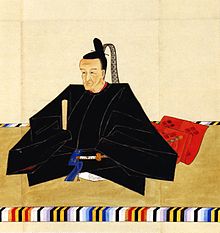Tokugawa Ieyoshi
| Tokugawa Ieyoshi | |
|---|---|
 |
|
| 12th Tokugawa Shogun | |
|
In office 1837–1853 |
|
| Monarch |
Emperor Ninkō Emperor Kōmei |
| Preceded by | Tokugawa Ienari |
| Succeeded by | Tokugawa Iesada |
| Personal details | |
| Born | 22 June 1793 |
| Died | 27 July 1853 (aged 60) |
Tokugawa Ieyoshi (徳川 家慶?, June 22, 1793 – July 27, 1853; r. 1837–1853) was the 12th shogun of the Tokugawa shogunate of Japan.
Ieyoshi died at 1853 and given buddhist name Shintokuin.
Ieyoshi was born as the second son of the 11th shogun, Tokugawa Ienari and named Inuchiyo. Inuchiyo was appointed heir on the death of his elder brother, Takechiyo. He became shogun on September 2, 1837, at the age of 45 upon the retirement of his father, Tokugawa Ienari. However, Ienari continued to wield much power from behind the throne, and it was not until after his death in 1841 that Senior Rōjū Mizuno Tadakuni was able to purge the government of his clique, and to implement measures to overhaul the shogunate’s finances and controls in the aftermath of the Great Tenpo Famine of 1832-36.
Known as the Tenpō Reforms, these numerous sumptuary laws attempted to stabilize the economy through a return to the frugality, simplicity and discipline that were characteristic of the early Edo period, by banning most forms of entertainment and displays of wealth. The restrictions proved extremely unpopular with the commoners.
Increasing criticism of the government’s handling of foreign affairs led to the Bansha no goku in 1839, suppressing rangaku studies.
Another part of the Reform included the Agechi-rei of 1843, which was to have daimyō in the vicinity of Edo and Ōsaka surrender their holdings for equal amounts of land elsewhere, thereby consolidating Tokugawa control over these strategically vital areas. However, this was also greatly unpopular amongst daimyō of all ranks and income levels. To complicate the situation further, in May 1844, Edo Castle burned down, and Mizuno Tadakuni was forced into exile and retirement. Mizuno was replaced by Doi Yoshitsura, Abe Masahiro and Tsutsui Masanori as rōjū. He forced the retirement of Tokugawa Nariaki in 1844 and placed Nariaki’s seventh son, Tokugawa Yoshinobu as head of the Hitotsubashi-Tokugawa house in 1847. He also forced the retirement of Shimazu Narioki in 1851.
...
Wikipedia
